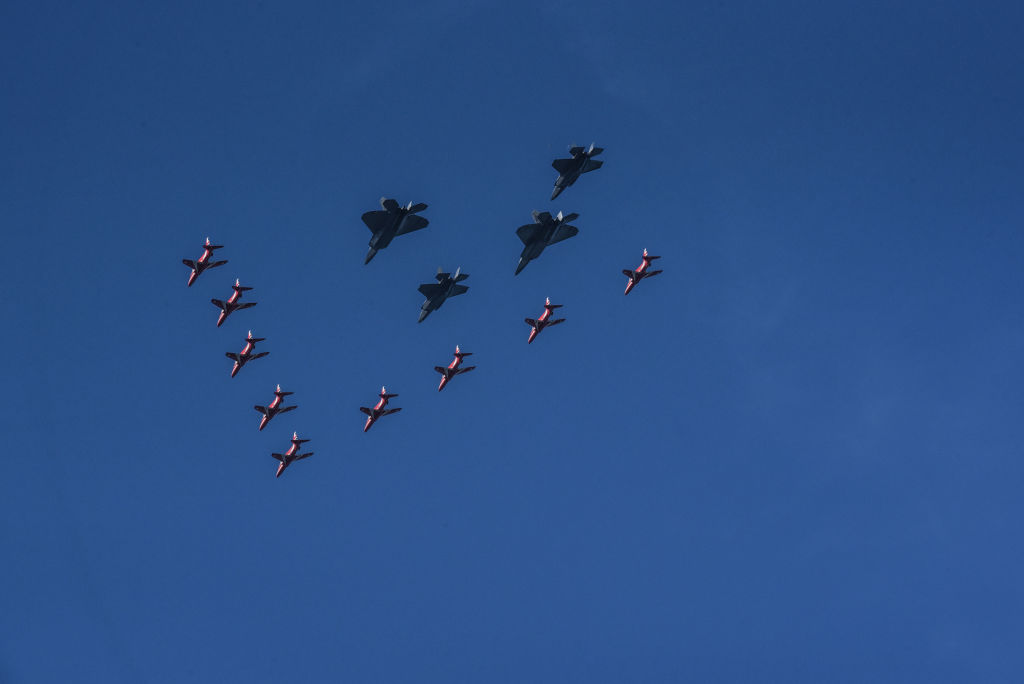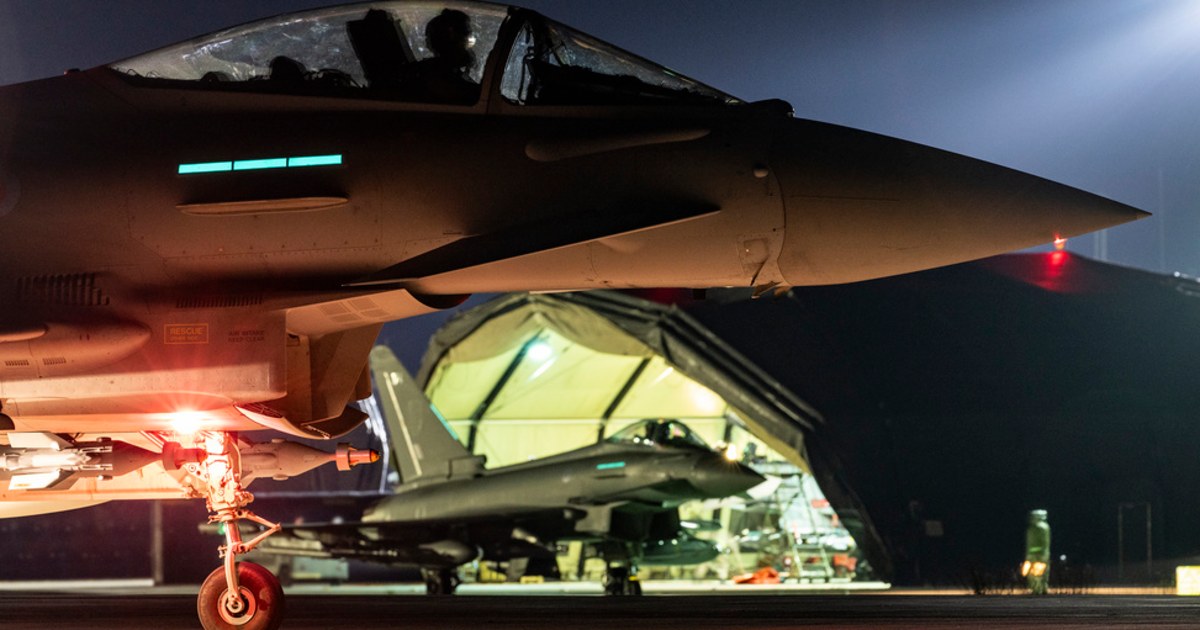There could be a "red phone" with China 0:38
Hong Kong (CNN) -
The United States Air Force will send more than two dozen F-22 stealth fighter jets to an exercise in the western Pacific this month, an unusually large deployment of the powerful jets that analysts say , sends a strong message to a potential adversary in China.
The Pacific Air Forces in Hawaii said this week that approximately 25 F-22 Raptors from the Hawaii Air National Guard and Joint Base Elmendorf-Richardson, Alaska, will be deployed this month to the Guam and Tinian Islands for Operation Pacific Iron. 2021.
"We have never had so many Raptors deployed together in the Pacific Air Forces area of operations," Pacific Air Forces commander Gen. Ken Wilsbach told CNN.
China will send 23 rockets to deflect giant asteroid 0:36
The F-22s are fifth-generation fighter jets, the most advanced in the world.
They incorporate stealth technologies and connect onboard sensor systems with external information systems to give their pilots a detailed view of the battlespace.
American F-35s are another example.
Deploying large numbers of F-22s for the exercise sends an immediate message to China at a time when relations are strained over Pacific hotspots like Taiwan and the South China Sea, said Carl Schuster, an analyst with Hawaii-based defenseman and former director of operations at the US Pacific Command Joint Intelligence Center Normal F-22 deployments consist of six to 12 aircraft, he said.
advertising
"The Pacific Air Force is demonstrating that it can deploy as many or more fifth-generation aircraft to the theater on short notice than (China) currently has in its entire inventory," he said.
China improves its capabilities
The Chinese air force has between 20 and 24 operational fifth-generation fighter jets, Schuster said, but noted that Beijing's capabilities are improving at a rapid rate.
The US Air Force has about 180 F-22 jets in its fleet.
However, only about half are capable of performing missions at any given time due to maintenance requirements, according to Air Force statistics.
Therefore, the United States will send approximately 25% of the mission's F-22s to exercise Pacific Iron.
Images would show Chinese military bunkers in the Himalayas 0:42
Due to their ability to evade radar detection, the F-22s would be expected to be among the first weapons used in any conflict.
Your task would be to eliminate an adversary's air defenses among other missions.
"The United States is actively practicing the deployments it will make if there is a major crisis or war. The United States is taking China very seriously. It is developing its posture of strength and training its forces so that it can move quickly into position." said Peter Layton, a former Australian air force officer now an analyst at the Griffith Asia Institute.
War exercises for Air Force aircraft
For Operation Pacific Iron, 10 F-15 Strike Eagle fighters from Mountain Home Air Force Base in Idaho and two C-130J Hercules transport jets from Yokota Air Base in Japan will join the F-22s to complete the air fleet for what the Air Force calls an Agile Combat Employment operation, also known as a combat dispersal operation, according to a statement from Pacific Air Forces.
The US military will leave Afghanistan much earlier than Joe Biden promised
The exercise is in support of the 2018 National Defense Strategy, "which called on the armed forces to be a more lethal, adaptive and resilient force," the statement said.
The Agile Combat Employment is designed to spread American fighter jets and other war assets among airfields in the region to increase their survivability from enemy missile attacks.
For example, much of the United States' combat air power in the western Pacific is concentrated in large military installations such as Kadena Air Base in Okinawa or Andersen Air Force Base in Guam.
An attack on those bases could cripple the US military's ability to strike back at an adversary if too much US air power is concentrated there.
How to counter China's growing might
At Pacific Iron, forces will practice from smaller and less developed airfields such as Tinian International Airport on the island in the Northern Marianas, Won Pat International Airport on Guam or Northwest Field, a remote strip separated from the main runways of the Andersen Air Force Base.
Lessons learned from the exercise could be applied to operation from smaller airports on islands around the western Pacific.
Afghanistan war appears to end with US exit 2:28
That would increase the number of targets that enemy missiles would need to destroy and give American airpower a better chance of being able to strike back.
A 2019 report by the RAND Corp think tank, funded by the US military, shows how the concept is conceived to counter growing Chinese capabilities.
The Chinese People's Liberation Army "possesses an ever-increasing quantity and quality of long-range precision cruise and ballistic missiles that can threaten key targets at air bases," the report says.
"Distributing aircraft to more locations improves survivability. An adversary must fire more missiles to achieve the same effect," he says.
"Demonstrating the agile combat capability of the US Air Force sends a strong deterrent signal to China and reassures (US) allies and partners," Schuster said.
"China will try to follow closely," he added.
One of the most complex deployments in history
Layton, the Australian analyst, said that using the F-22 jet presents the US Air Force with some degree of difficulty.
"The F-22 is one of the most difficult aircraft for this type of deployment exercise in terms of mission and maintenance support. If you can do this with the F-22, then do it with any other US tactical fighter jet. It should be easy, "Layton said.
Wilsbach, the commander of the Pacific Air Forces, called Pacific Iron "one of the most complex deployments we have ever organized."
Artificial intelligence as co-pilot of US military aircraft 1:32
"We can move forces and capabilities around the world at will. But what matters most is what they do when we unite these capabilities," said the general.
A successful exercise would have a deterrent value for China, Layton added.
"While this is an exercise, the same techniques, processes and procedures would be crucial in operations from Japan or elsewhere. For Chinese military planners, it could suggest that such F-22 force packages could be deployed anywhere on the periphery. from China, "Layton said.
The Air Force used Guam's Northwest Field to practice Agile Combat Employment operations in February, refueling F-35 and F-16 fighter jets that were unable to return to their home bases in a simulated combat situation.
Air Force Technical Sgt. Todd Johnson, who participated in the February exercise, used a sports analogy to describe the concept.
"Think of it like a pit stop in NASCAR. If you have a well-trained and organized team, then a jet will be able to land, get a security check, refuel and be ready to go back to the sky in just minutes," he said in a statement. Air Force press release on that exercise.






